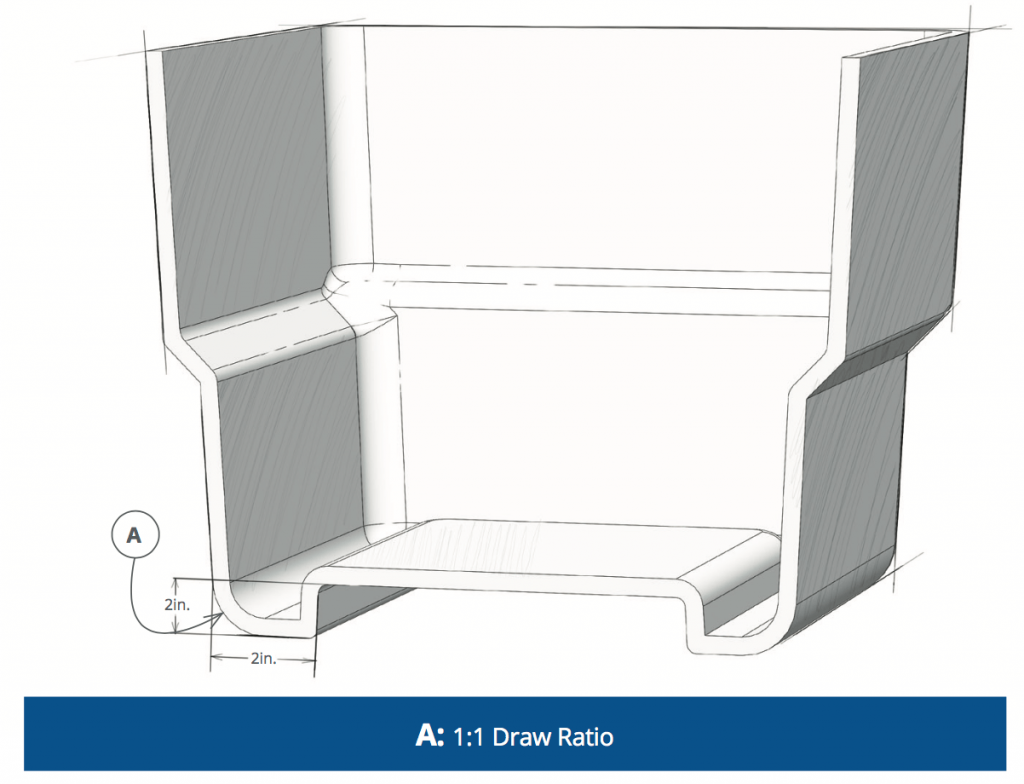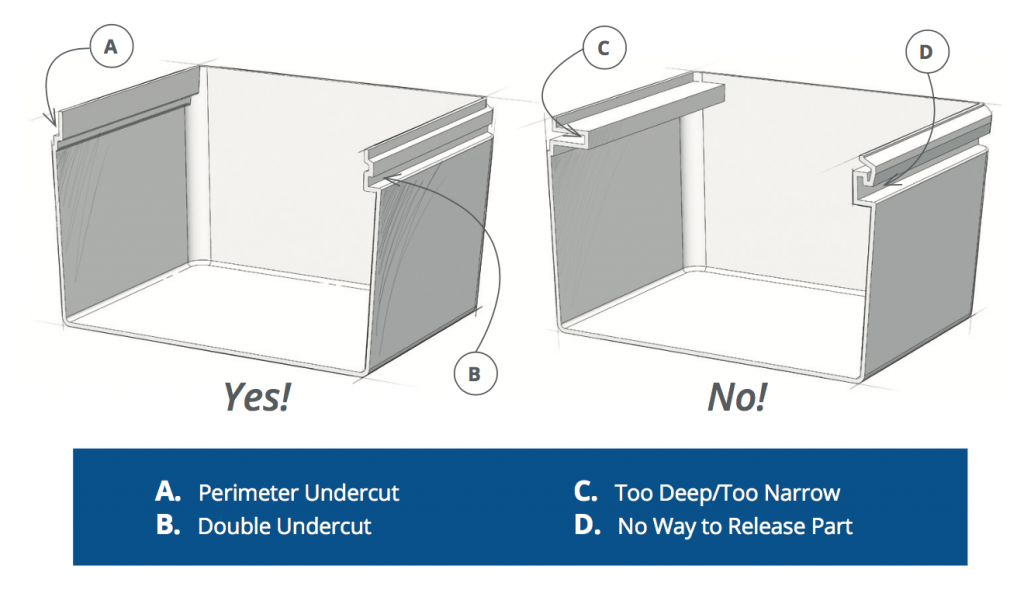Thermoforming covers all processes which involve heat to shape polymers. Y adding small holes through the mold and attaching a.

Pdf Design For Additive Manufacturing Thermoforming Mold Optimization Via Conformal Cooling Channel Technology
Mold Design and Materials.
. Proper design will account for these characteristics. Were releasing the whole thing in a series of posts right here on our blog. Thermoforming is the heating of a plastic sheet which is then draped over a mold while vacuum is applied.
PTI will default to ABS unless specified differently. In deciding between plastic thermoforming and injection molding for your next project there are several important factors to keep in mind. 3 Use a plug assist.
1 Sheet is heated to thermoforming temperature. Development design machine and mold technology and production as well as the latest innovations from thermoformed bottles to fully automated assembly lines. For experimental or short runs wood and plaster are the most commonly used materials.
4 Part removed and CNC trimmed to specification. To reduce the risk of wrinkling when molding deep shapes a male mold is. Thermoforming is a process that uses heat and pressure to mold a flat sheet of thermoplastic.
The molded plastic parts are then trimmed and inspected for quality. PMP always say. A two-sided matching mold with both male and female sections is shown in Figure D-1.
Molds may be male female a combination of both or two-sided. We have created this Design Guide as an engineering aid for our many good clients as well as our potential. THERMOFORMING DESIGN GUIDELINES Revision 3-12-18 Multifab Inc.
Place the DuPont Corian sheet into the preheated platen press with the heat setting between 300 and 325F 150 and 165C. The process is widely used in packaging of consumer products and to fabricate large items such as bathtubs contoured skylights and internal door liners for refrigerators. Advances in Science and Technology Research Journal Volume 11 Issue 3 September 2017 pages 139142 Research Article DOI.
It is important to remember that the start of the. This combination provides us control over the mold design and the capacity to meet demanding delivery schedules. Design for Thermoforming Uniform thickness 10 Simpler shapes avoid under cuts etc Rounded corners 1t min 4t ideal Draft angle for removal 5 5 degree Depth of draw ratio 11 Stretch ratio 21 Shrinkage Design for holes and trim lines 30 Cost -.
Thermoforming is a relatively simple process to convert a flat plastic sheet into a three-dimensional object. Several experienced outside mold makers with whom we have worked for many years. 3 Air is applied above the mold and vented below to form shape.
Thermoforming is a process that involves heating a flat sheet of plastic until it is soft enough to mold. Design guidelines for the thermoforming process 5 5 1. Contact with the cold mold surface and the par Thermoforming is a process in which a flat thermoplastic sheet is heated and deformed into the desired shape.
Thermoforming particularly pressure forming is more cost effective for very large parts where the. Once it reaches the right temperature the sheet advances to the form section. Executive Summary This report reviews the choices that may be considered for thermoforming processing.
This review provides a brief discussion of the thermoforming process including its historical. This is accomplished by shaping the sheet while it is at or above the forming temperature holding the sheet in the new configuration and removing. Poor Mold Design 2 Increase the draft and radii of the mold design.
Cast phenolic and epoxy resin molds work well. Thermoforming is a process that uses heat and pressure to mold a flat sheet of thermoplastic material to a particular shape. Thermoforming molds can be produced from a wide variety of materials depending on the size of the part quantity detail and dimensional accuracy required.
Thermoforming is a broad technology genre so the report gives some background information to the various thermoforming process sub groups and links the tooling. 508-865-8150 4 There are several different terms used to describe. In this guide we will focus on the vacuum forming and pressure forming processes.
This is the second post in our series from our Thermoforming Handbook a guide that until now was only available to our customers and partners. A rough guideline is that the sheet should be heated one minute for every millimeter so 6 mm 1. Tooling costs for thermoforming are significantly lower than tooling costs for injection molding.
6 If tooling is multiple mold design increase the distance between molds. 2 Heated plastic sheet is placed over the mold face covered. Mold cooling design cooling methods and the importance of accurate and consistent hook-ups are emphasized.
Designing for Thermoforming. 15 created a finite element-based optimization approach for. From the Design Guide Chapter 2.
MOLD DESIGN CONCEPT PLUG VS CAVITY The primary purpose of the mold used in the thermoforming process is to create the desired part geometry. A good design is the heart of a Mold One of the most fundamental decisions when designing a mold for the plastics thermoforming process is whether to use a plug male mold or a. 4 for 6 minutes 12 mm 1.
Proper design will account for these characteristics. 1 Thermoplastic sheet is secured heated to forming temperature. Various kinds of materials have been used successfully in making molds for vacuum forming.
Chapter 1s blog post is right here. In its simplest form thermoforming involves heating up a plastic sheet until it is pliable then stretching it over a mold and letting it cool so it sets to the mold shape. The sheet is pulled into the mold with a vacuum.
Download Full PDF Package. The plastic hardens and forms the desired part. Is an industry leader in the field of vacuum and pressure formed plastics for the Aerospace Medical and other commercial industrial markets.
14 applied topology optimization for the design of a conformal cooling layout of a thermoforming mold. 4 Add take-up blocks web catchers to pull material away from the corners. Vacuum Thermoforming Process Design Guidelines 1 Materials.
10129132299862471148 AN EXPERIMENTAL STUDY ON WALL THICKNESS DISTRIBUTION IN THERMOFORMING Sencer Süreyya Karabeyoglu1 Olcay Ekşi1 Selçuk Erdoğan2 1 Kırklareli. Generally speaking amorphous materials like polystyrene ABS polycarbonate PVC and PVCAcrylic blends are easier to vacuum form. Mold design is closely interrelated to part design and will depend on the following factors.
Thin Sheet Thermoforming Mold Design Machine Controls Forming and Cooling the Parts This lesson explains the common types of molds used in thermoforming along with good and bad cooling design layouts. The molding is then cooled before it is ejected from the mold using reverse pressure. The platen oven should be set to the desired sheet temperature.
5 Use recessed pockets web moats in web areas.

Designing From The Design Guide Chapter 2 Ray Products

Thermoforming Process An Overview Sciencedirect Topics

Advanced Thermoforming Methods Machines And Materials Applications And Automation Engelmann Sven 9780470499207 Chemical Engineering Amazon Canada

0 comments
Post a Comment